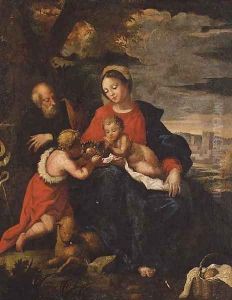Guilio Cesare Procaccini Paintings
Giulio Cesare Procaccini was an Italian painter and sculptor of the early Baroque period, born in Bologna in 1574. He was part of a family of artists; his father Ercole Procaccini the Elder was a painter, and his brothers Camillo and Carlo Antonio were also involved in the arts. Giulio Cesare initially trained as a sculptor under his father's guidance before turning to painting. He moved to Milan with his family in the late 1580s, where he was profoundly influenced by the work of Lombard artists, such as the Campi brothers, and the Counter-Reformation principles which emphasized a more emotional and dynamic approach to religious subjects.
Procaccini's painting style is characterized by its vigorous movement, robust figures and emotive expressions, blending Mannerist elements with the emerging Baroque sensibility. He was accomplished in both fresco and oil painting, and his work included altarpieces, portraits, and mythological scenes. His art was marked by a combination of elegance and energy, with a particular talent for depicting soft, cherubic figures and using a rich palette.
Throughout his career, Procaccini received significant commissions from religious institutions and was active in decorating many of the churches in Milan, such as San Maria presso San Celso and San Fedele. His work was not confined to Milan; he also worked in Genoa and Piacenza, among other places. Procaccini was influential in the development of the Lombard and Genoese schools of painting, and his style was a precursor to the high Baroque style that would come to dominate Italian art later in the century.
Procaccini's contribution to Italian art was significant, and his works were collected and admired by many. Unfortunately, his career was relatively short; he died in Milan in 1625. Despite this, his legacy lived on through his influence on other artists, such as Daniele Crespi and Giovanni Battista Discepoli, who carried forward the stylistic traits of dynamism and expressiveness that Procaccini had helped to pioneer.
